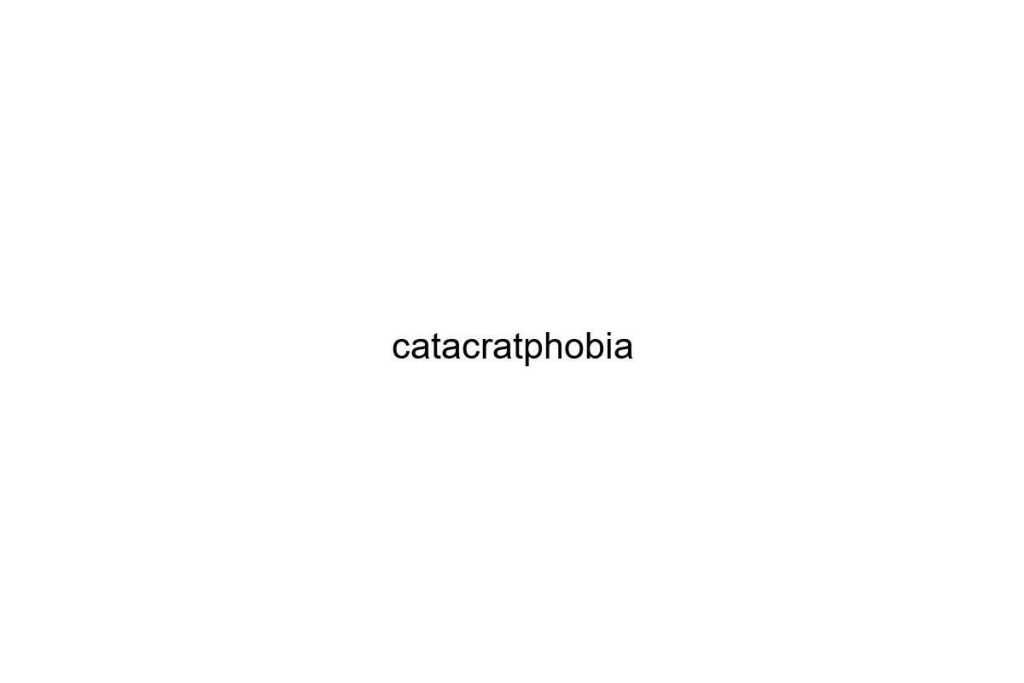Have you ever felt an inexplicable fear of failure or making mistakes? If so, you might be experiencing catacratphobia, a term that’s not widely known but affects many people. This phobia can stem from a deep-seated anxiety about not living up to expectations, whether they’re self-imposed or from others.
Understanding catacratphobia is crucial for anyone looking to overcome the paralyzing effects it can have on their life. I’ve seen how this fear can hold individuals back from pursuing their dreams and achieving their goals. In this article, I’ll explore the roots of catacratphobia, its symptoms, and effective strategies for conquering it. Let’s dive into this often-overlooked phobia and discover how to break free from its grip.
Understanding Catacratphobia
Catacratphobia represents a significant barrier to achieving personal goals due to an intense fear of failure and making mistakes. Recognizing its traits and symptoms leads to effective strategies for overcoming this phobia.
Definition of Catacratphobia
Catacratphobia is defined as an irrational fear of making mistakes or failing in various aspects of life. Individuals with this phobia often dread the possibility of disappointing themselves or others, which can stem from past experiences or high self-imposed expectations. The term “catacratphobia” combines “cata,” a prefix indicating downward movement, with “cratio,” related to judgment, highlighting how this fear pulls individuals down from their potential.
Symptoms and Signs
Recognizing the symptoms of catacratphobia is crucial for addressing its effects. Common symptoms include:
- Anxiety: Experiencing intense worry or restlessness before tasks involving risk of failure.
- Avoidance: Steering clear of situations where mistakes may occur, such as public speaking or decision-making.
- Perfectionism: Setting excessively high standards for oneself, leading to stress and dissatisfaction.
- Procrastination: Delaying tasks to avoid facing potential pitfalls or errors.
These signs can significantly affect daily life, restricting opportunities for growth and enhancing self-doubt. Addressing these symptoms is essential to regain control and pursue aspirations confidently.
Causes of Catacratphobia
Catacratphobia arises from a combination of psychological and environmental influences. Understanding these causes is vital for addressing and overcoming the fear of making mistakes and failing.
Psychological Factors
Psychological factors significantly contribute to catacratphobia. Individuals often struggle with low self-esteem, which fosters a constant fear of inadequacy. Negative past experiences, such as harsh criticism or failure, can reinforce this fear, creating a cycle of anxiety. Cognitive distortions, like all-or-nothing thinking, lead to unrealistic expectations. Information processing styles that emphasize mistakes over achievements further fuel this phobia. Individuals may also experience anxiety disorders or perfectionism, making the fear of failure more pronounced.
Environmental Triggers
Environmental triggers play a crucial role in developing and perpetuating catacratphobia. High-pressure situations, such as competitive work environments or academic settings, can intensify the fear of failure. Social comparisons, especially in cultures that prioritize success, heighten feelings of inadequacy. Past experiences with authoritative figures who imposed strict standards can sow seeds of fear, as individuals grow to associate these interactions with potential failure. The influence of family dynamics, such as overcritical parents or a lack of support, shapes one’s perception of mistakes and success. Recognizing these triggers is essential for managing and overcoming catacratphobia.
Diagnosis and Assessment
Assessing catacratphobia involves a comprehensive approach, combining medical evaluation with psychological assessment to identify the fear’s impact and underlying causes.
Medical Evaluation
A medical evaluation helps rule out underlying health issues contributing to anxiety. I recommend consulting a healthcare provider when experiencing symptoms like chronic anxiety, sleep disturbances, or physical symptoms. The provider may conduct a physical examination, review medical history, and recommend lab tests to exclude conditions such as hyperthyroidism or anxiety disorders. It’s vital to approach this evaluation with openness to ensure an accurate diagnosis.
Psychological Assessment
A psychological assessment plays a crucial role in diagnosing catacratphobia. I often recommend standardized questionnaires, such as the Fear of Failure Scale, to gauge intensity and frequency of the fear. Mental health professionals may conduct structured interviews to explore behavioral patterns, thoughts, and feelings associated with the fear of making mistakes. Techniques such as cognitive-behavioral assessments can also be used to identify cognitive distortions and to develop targeted interventions for overcoming this phobia.
Understanding both medical and psychological factors enables a tailored treatment approach, addressing catacratphobia effectively.
Treatment Options for Catacratphobia
Effective treatment for catacratphobia focuses on both therapeutic and medicinal strategies. Addressing this fear of failure involves understanding personal experiences and employing targeted interventions.
Therapy Approaches
Cognitive Behavioral Therapy (CBT) provides a structured approach to address catacratphobia. CBT helps me identify negative thought patterns and replace them with positive, constructive beliefs. Exposure therapy gradually introduces me to situations that provoke anxiety, decreasing avoidance behavior. Acceptance and Commitment Therapy (ACT) encourages me to accept my fears while committing to actions aligned with my values. Group therapy offers support and shared experiences, fostering a sense of community and reducing feelings of isolation.
Medication
Medications can complement therapeutic approaches for catacratphobia. Selective Serotonin Reuptake Inhibitors (SSRIs) reduce anxiety and enhance mood stability. Benzodiazepines may provide short-term relief from acute anxiety symptoms but carry a risk of dependency. Consulting a psychiatrist helps determine the right medication and dosage based on my individual needs. It’s essential to consider medication as part of a comprehensive treatment plan for the best results.
Living with Catacratphobia
Living with catacratphobia can feel overwhelming. However, there are effective strategies and support systems that can help manage this fear.
Coping Strategies
- Practice Mindfulness: Mindfulness techniques, such as meditation and deep breathing, foster awareness of thoughts without judgment. This practice helps me stay grounded and reduces anxiety in triggering situations.
- Set Realistic Goals: Establishing achievable goals allows me to focus on progress rather than perfection. Breaking tasks into smaller, manageable steps minimizes feelings of being overwhelmed.
- Embrace Mistakes: Viewing mistakes as learning opportunities can shift my perspective. Celebrating small achievements reinforces positive experiences and reduces fear associated with failure.
- Challenge Negative Thoughts: Identifying and disputing negative thought patterns is crucial. I write down my fears and counter them with rational, positive statements to reframe my mindset.
- Gradual Exposure: Gradually facing fears in controlled settings diminishes their power. I start with less daunting tasks before tackling more significant challenges, which builds my confidence over time.
Support Systems
- Therapists and Counselors: Professional help is invaluable. Therapists trained in CBT and other modalities guide me in addressing catacratphobia and developing coping mechanisms.
- Support Groups: Engaging with others who share similar fears provides understanding and encouragement. Support groups can offer a safe space for sharing experiences and learning from others.
- Friends and Family: Open communication with loved ones fosters a supportive environment. Sharing my feelings ensures that I receive empathy and encouragement during difficult moments.
- Online Communities: Online forums and groups focus on mental health issues. These digital spaces provide resources and allow me to connect with individuals facing similar challenges.
- Educational Resources: Accessing books, articles, and videos about catacratphobia aids in understanding the phobia. Knowledge empowers me to tackle my fears and employ effective strategies.
Conclusion
Catacratphobia can feel overwhelming but understanding it is the first step toward overcoming its grip. By recognizing the roots of this fear and its impact on my life I can begin to reclaim my aspirations. Embracing mistakes as part of the learning journey is essential for personal growth.
Utilizing effective strategies and support systems can make a significant difference in managing this phobia. I’ve learned that I’m not alone in this struggle and that seeking help is a sign of strength. With patience and persistence I can break free from the constraints of catacratphobia and move towards a more fulfilling life.
Frequently Asked Questions
What is catacratphobia?
Catacratphobia is an irrational fear of making mistakes or failing. It often stems from past experiences and high self-imposed expectations, which can limit personal growth and achievement.
What causes catacratphobia?
Catacratphobia can be triggered by psychological factors like low self-esteem and anxiety disorders, as well as environmental influences such as high-pressure situations and critical family dynamics.
What are the symptoms of catacratphobia?
Symptoms include anxiety, avoidance of risk, perfectionism, and procrastination. These feelings can restrict opportunities for personal growth and enhance self-doubt.
How is catacratphobia diagnosed?
Diagnosis typically involves a comprehensive approach combining medical evaluations to rule out health issues with psychological assessments, including standardized questionnaires, to gauge the fear’s intensity.
What treatment options are available for catacratphobia?
Effective treatments include Cognitive Behavioral Therapy (CBT), Exposure Therapy, Acceptance and Commitment Therapy (ACT), and group therapy. Medications like SSRIs may also be prescribed under a psychiatrist’s guidance.
How can someone cope with catacratphobia?
Coping strategies involve practicing mindfulness, setting achievable goals, embracing mistakes, challenging negative thoughts, and gradually exposing oneself to fears, alongside seeking support from friends, family, and professionals.



